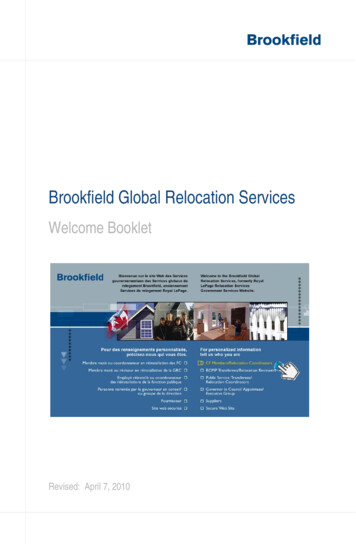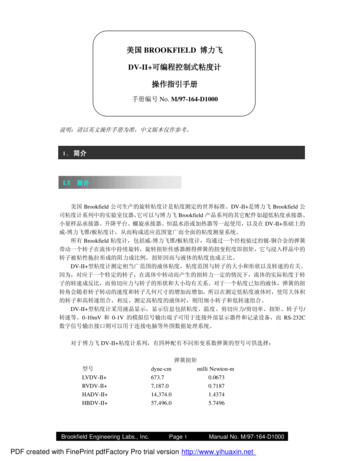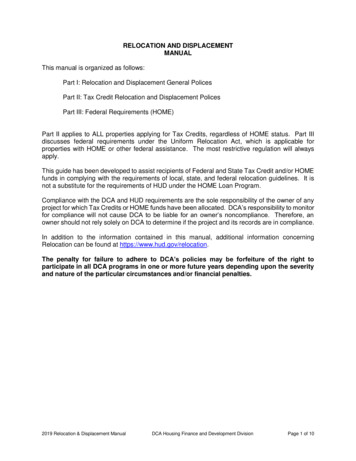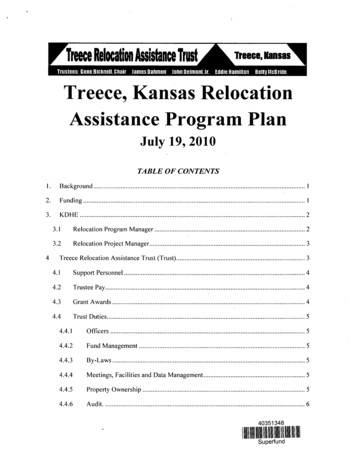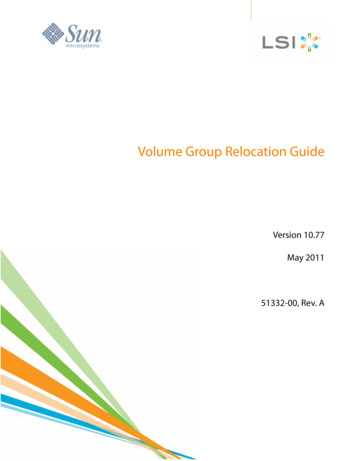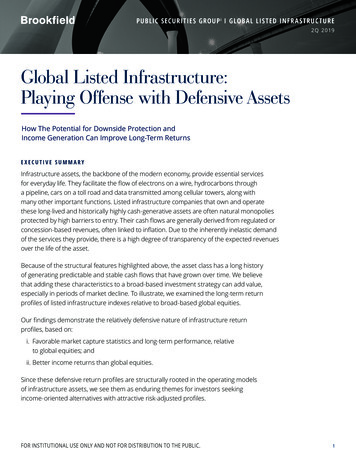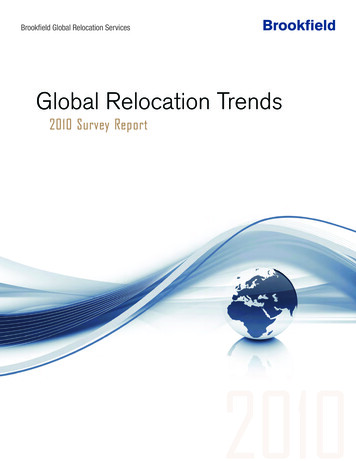
Transcription
Brookfield Global Relocation ServicesGlobal Relocation Trends)'(' Jlim\p I\gfik)'('
2010 Brookfield Global Relocation Services. All rights reserved.This book may not be reproduced, in part or in whole; in any form, or by any means,without the expressed written consent of Brookfield Global Relocation Services.Printed in the United States of America.
Global Relocation Trends)'(' Jlim\p I\gfikBrookfield Global Relocation Services, LLCBrookfield Global Relocation Services is the trusted leader for the design andmanagement of domestic and international relocation and assignment servicesthroughout the world. We passionately believe that our integrity, transparency,flexibility and commitment to our clients and each other enable us to deliver acost effective Premier Service experience to everyone we serve.Our 800 employees operate from regional offices in Asia, Europe and NorthAmerica to support the success of our clients and their relocating employeesaround the world. We have the local knowledge and worldwide presence todevelop and implement global employee relocation solutions.Brookfield Global Relocation Services is an operating company of BrookfieldResidential Property Services, a leading global provider of real estate andrelocation services, technology, and knowledge.To find out more visit us at:brookfieldgrs.com, or email us atreloadvisor@brookfieldgrs.com.)'('
Table of ContentsContentsIntroduction5AN INDUSTRY STANDARDIN THIS REPORT55Purpose and Methodology6NUMBER OF EXPATRIATES PER COMPANYPARTICIPANT REPRESENTATION BY INDUSTRYINTERNATIONAL RESPONSE RATES667Key Findings8THE EXPATRIATE POPULATIONEXPATRIATE SOURCES AND DESTINATIONSASSIGNMENT TYPES AND BENEFITSGLOBAL BUSINESS STRATEGYCULTURAL AND FAMILY ISSUESASSIGNMENT EVALUATION AND COMPLETIONCOST ESTIMATES, TRACKING, AND COMPARISONSOUTSOURCING8991011121313Survey HighlightsTHE EXPATRIATE POPULATIONEXPATRIATE SOURCES AND DESTINATIONSASSIGNMENT TYPES AND BENEFITSGLOBAL BUSINESS STRATEGYCULTURAL AND FAMILY ISSUESASSIGNMENT EVALUATION AND COMPLETIONCOST ESTIMATES, TRACKING, AND COMPARISONSMEASURING RETURN ON INVESTMENTCOMPENSATIONOUTSOURCINGNEW AND INNOVATIVE PROGRAMSSurvey Findings in Detail15151515161617171818181921
Table of Contents
IntroductionAN INDUSTRY STANDARDThe 2010 Global Relocation Trends Survey Report is the 15th annual report issued by Brookfield GlobalRelocation Services (Brookfield GRS). These reports constitute one of the industry’s most reliable sources ofglobal relocation data and trends. The longevity of this report enables us to compare each year’s results with“historical averages” that include data from the current year and previous years; this helps readers to gauge therelative importance of annual variations. Each year, this report is used as a benchmark for policy developmentand it is cited in major business publications and journals that specialize in international business.IN THIS REPORTThis year’s survey contained 120 questions and was available online. It comprises the following characteristics: It reflects information current through the close of January 2010. It elicits details pertaining to expatriate demographics, key destinations, challenging destinations, expatriateprogram management structure, assignment expense management, assignment types and policystructures, localization considerations and practices, expatriate compensation management, repatriationpolicies, expatriate attrition rates, cross-cultural training, return on investment, assignment evaluation andfailure, and the management of outsourced services. The 120 respondents represented small, medium, and large organizations with offices located throughoutthe world. Participating companies ranged in size from having as few as two international locations to 4,050 branchlocations. Together they managed a total world-wide employee population of nearly 5.8 million. 55% of the responding companies were headquartered in the Americas; 43% were headquartered inEurope, the Middle East, and Africa; 2% were headquartered in the Asia-Pacific region. In most cases, respondents were senior human resource professionals and/or managers of internationalrelocation programs.
Purpose & MethodologyNUMBER OF EXPATRIATES PER COMPANYThe percentage of respondents who represented companies with small expatriate populations (one to 25expatriates) continued to be low (18%) compared to previous years. The percentage of respondents withslightly larger populations (26 to 50 expatriates), however, was the largest (20%) in the history of thisreport. The number of companies with 501 to 1,000 expatriates also was the largest (12%) in the historyof this report.Percentage of Responding Companies by Size of Total Expatriate 992000200120022003/4200520062007200820091 - 2525%29%32%54%41%36%35%29%48%27%21%15%17%18%26 - 8%6%3%5%5%8%6%2%7%9%10%10%12%Over 1,0006%3%4%1%7%8%6%5%6%13%14%13%8%10%PARTICIPANT REPRESENTATION BY INDUSTRYAs in past years, respondents represented a range of industries, and an authorized list of participatingcompanies appears at the end of this survey report. Participation by companies in the following categorieswas higher than in all or most previous reports: Construction, Engineering Transportation Participation by companies in only one category was lower than in all or most previous reports: Services (Publishing, Advertising, Hospitality, and Entertainment).Survey Participants by IndustryIndustry SegmentPercentage of ormation Technology *19%18%20%14%15%24%17%14%20%18%Machinery, Shipbuilding, Manufacturing, Aerospace18%19%17%11%17%8%11%12%15%12%Consumer Products, Retailing12%10%9%14%8%13%13%10%13%12%Finance, Insurance, Real Estate16%15%14%14%10%14%11%16%8%12%Energy, Utilities, Mining8%8%10%6%8%6%8%8%7%8%Construction, Engineering3%3%4%3%2%4%5%7%7%8%Services (Publishing, Advertising, Pharmaceuticals, Medical Devices, 1%1%3%–2%7%8%3%7%Chemicals, %2%3%3%* The information technology category includes electronics, computers, software, e-commerce, and telecommunications
Purpose & MethodologyINTERNATIONAL RESPONSE RATESSince 1999, we asked companies to identify the location of their headquarters. In the current report: 55% were headquartered in the Americas. 43% were headquartered in Europe, the Middle East, and Africa. 2% were headquartered in the Asia-Pacific region.The following table summarizes all previous and current responses:Location of Company HeadquartersYearAmericasEMEAAsia -200090%10%-199992%8%-
Key findingsTHE EXPATRIATE POPULATIONOnce again, concerns about the economic climate affected the size and composition of the expatriatepopulation. Last year (2009 report), 33% of respondents predicted growth, but only 27% coulddemonstrate an increase in the current report. It was the second-lowest increase in the history of thisreport (2001 report holds the record for the lowest increase in expatriate population). In the same vein,last year only 25% expected a decrease in the population, but 46% reported a drop in the current report.Those who expected the population to remain unchanged were even less accurate – with 42% predictingstability last year and only 27% currently reporting no change. The variation between the predictions ofvolume and what actually happened is clearly a reflection of the uncertain economy and the difficulty ofcoming up with a clear strategy to address both short term pressures and longer term business plans.Validating these findings, respondents adopted a cautious approach toward hiring. Only 8% of expatriateswere new hires. It was the lowest percentage in the history of the report, and it compared to a historicalaverage of 12%. It is possible that a drop in graduate recruiting contributed to the decrease.Despite the drop in expatriate population and apparent hiring freeze, respondents expressed cautiousoptimism about the future. Only 12% expected a decrease in the expatriate population (compared to 25%in the 2009 report); 44% expected an increase, and another 44% expected the population to remain thesame. The data may reflect the variety of destinations to which expatriates were sent. Consequently, futuregrowth and optimism may be experienced by companies that send expatriates to Brazil, Russia, India, andChina (BRIC).We also recorded a retrenchment that was reflected in the age, gender, and marital status of expatriates aswell as in a number of accompanied assignments. Most fundamentally, the expatriate population becameolder as companies selected more experienced employees for assignments. Expatriates in the 40-to-49year group increased from 37% to 40%, and those in the 50-to-59-year group also increased from 14%to 16% during the past year. At 17%, the percentage of female expatriates in the current report was thelowest since the 2001 report, when it was 16%. In addition, the increasing age of expatriates also waslinked to an increase in the percentage of married males. At 63% it was higher than at any time since the1999 report.In yet another area, the increasing age of the expatriate population was linked to a drop in the percentageof accompanying children. Employees in the 40-to-59-year age group typically have fewer children athome and attending school than employees in the 30-to-39-year group. Consequently, the percentage ofexpatriates with accompanying children was the lowest in the history of this report at 47% (compared toa historical average of 56%). In a related trend, the percentage of expatriates accompanied by spousesfell to 79% – the second-lowest percentage in the history of this report (the historical average was 85%).We also connect these results with other findings, particularly those around commuter assignments whichare typically unaccompanied. We found that 35% of respondents indicated that they utilized commuterassignments, as opposed to 29% for 2009, and that 36% are considering using a Commuter policy asopposed to 30% in 2009. We believe that dual career and the education needs of older children impactwhether or not spouses and families accompany the expatriate on assignment.Finally, it became more difficult for previously employed spouses to obtain employment duringassignments. Only 9% were employed both before and during assignments, compared to a historicalaverage of 14%. In contrast, 50% of partners were employed before (but not during) assignments,compared to a historical average of 48%. We suspect that the difficulties in finding partner employmentwere related to economic conditions or to the locations where expatriates were posted. Language andcultural difficulties may inhibit employment and the challenges of immigration may make potentialemployers unwilling to consider an expatriate spouse candidate who would need immigration support.
Key findingsEXPATRIATE SOURCES AND DESTINATIONSThe current report reflects a continuation of the globalization trend. For example, only 56% of assignmentsinvolved relocation to or from a headquarters country. This was the lowest percentage in the history of thereport and it compares to a historical average of 62%. It also signals an increase in reliance upon thirdcountry nationals for assignments (transferees between locations that do not include the headquarters).Furthermore, there has been an increase in the percentage of intra-regional transfers – from 22% in the2009 report to 27% in this report. Among companies that rely on intra-regional transfers, 49% tookplace within Europe, the Middle East, and Africa; 26% within the Americas; and 25% within theAsia-Pacific region.The United States and China were the top expatriate destinations – reversing the order of the 2009 report.The United Kingdom remained in third position. The results for emerging assignment locations, however,were surprising. While China remained in the top position, Singapore moved from fourth to second place.While India fell from second to fourth place, the United States rose to third place – climbing from itsnineteenth position in the 2009 report. Another unexpected change was Russia; it fell from third positionin the previous report to twenty-first position. We believe that this is possibly a reflection of the continuingstrains in the Russian economy.China, India, and Russia led the list of countries that were most challenging for expatriates – making thisthe fourth consecutive report without a change in the ranking. This year, India took the top position as themost challenging destination for program managers – replacing China, which had held the top positionsince the 2003/4 report. Russia remained in third position, which it has held since the 2006 report.To obtain more specific information about key areas of concern, for the first time we asked which countrieswere most challenging for housing, temporary accommodation, and immigration. For both housing andtemporary accommodation, China and India were the most challenging. For immigration, Russia, theUnited Kingdom, India, and the United States were the most challenging. The United Kingdom, ranking inparticular, is a reflection of changes to immigration law and the United States continues to mirror ongoingsecurity concerns. As in the 2009 report, China and India topped the list of locations with the highest ratesof assignment failure, and the United States was in third position (replacing the United Kingdom).ASSIGNMENT TYPES AND BENEFITSThere was a slight increase in the percentage of long-term assignments, from 61% in the 2009 reportto 64% in the current report. The percentage for short-term remained unchanged and for one-wayassignments it actually decreased 1% from 12% to 11%. With regard to expectations about assignmentlength, respondents presented a more complex picture: On one hand, they expected more assignments of six months to one year – 15% in the current reportcompared to 11% in the previous report. On the other hand, for assignments of one to three years in length, there was a decrease inexpectations – from 55% to 47% in the current report. At the same time, there was an increase in the number of expected three-to-four-year assignments– from 13% to 18%.The shorter assignments may be less costly and less disruptive, and are sometimes easier to approvethan longer assignments. However, in spite of this, it is only the expectation of an increase in short termassignments that we see so far and it remains to be seen if this translates into an actual increase.With regard to the expected increase in three-to-four-year assignments, we believe that companiesare hoping to keep expatriates on existing assignments for an extra year rather than to replace themwith another expatriate, which is very costly, or possibly if there are no open positions available for theexpatriate upon their return.We also noted a shift in the percentage of assignments that were completed on schedule. Compared to the2009 report, there was a 3% decrease in assignments completed on schedule – from 62% to 59%. The
Key findingstop responses to the question ‘why some assignments required additional time to complete’ were a changein business needs, expansion in the project scope, and because there was no successor ready to replacethe expatriate. All of these reasons speak again to the less predictable economic times that companies arefacing. It is possible that assignment duration is positioned optimistically as part of the approval processbut that reality intervenes later and assignments are then extended when necessary. While assignmentextensions are unavoidable at times, we urge mobility managers to avoid the practice of transformingshort-term assignments into long-term assignments because of the corresponding tax implications andadditional expenses.Regarding policies that are currently in place, we noted increasing use of policies for localization (from52% to 58%). We believe that this reflects the fact that localization was once only a “practice” and arecent increase in use of this practice has prompted companies to develop corresponding “policy”. Theincrease in local-hire policies from 37% to 38% and the increase in commuter policies from 29% to 35%,however, are certainly in line with trends we have seen developing over recent years. On the other hand,the percentage of extended business travel policies has fallen from 47% to 44%. This may signal anothershift. Extended business travel was once viewed as a cheap alternative to an assignment, but it is difficultto administer in terms of taxes and immigration and carries a great deal of compliance risk if not done well.Furthermore, when we asked which policies are being considered for the future, commuter assignmentpolicies increased from 30% in the 2009 report to 36% currently. This again is consistent with thesignificant increase within the industry in this type of assignment. We also noted that the practice oflocalizing expatriates after five or more years was at an all time high: 44%. We believe that this is aresult of companies experiencing increased pressure to reduce costs and the administrative burdenof assignments by shifting long-term expatriates to local status. Furthermore, we noted the followingdevelopments regarding the benefit-transition schedule: There was a reduction in the percentage of respondents that transitioned expatriates immediately tothe local benefits structure – from 43% in the 2009 report to 37% in the current report. At the same time, there was an increase from 7% to 11% in respondents who transitioned expatriatesduring a one-year period.These results can be explained by acknowledging that localization has become a more common practicein the current economic climate. However, in many cases, the lack of a transition period seriously inhibitsthe ability or willingness of expatriates to accept a localization. In response to expatriates’ reluctance tolocalize, companies may be providing an incentive to make the transition to local benefits by offering astructured transition to local benefits over the period of one year.GLOBAL BUSINESS STRATEGYThis report documented a record high percentage (58%) of revenue generated outside of the headquarterscountry; the historical average was 44%. It is therefore not surprising that only 56% of expatriateassignments involved relocation to or from a headquarters country.For the first time, we asked respondents to identify where the mobility function reports within the corporatestructure. There has been some excitement about closer collaboration between international mobilityand talent management functions, but when we tabulated the results, only 4% indicated a reporting lineto talent management. In fact, 56% of respondents reported to corporate human resources, and 31%reported to the compensation and benefits function. The lack of innovation in the traditional pattern ofreporting relationships perhaps speaks to the difficulty of making the significant organizational changesthat would be required in order for mobility to report to talent management.The centralization of the decision-making process has reached the highest level in the history of this report:96% of respondents reported that relocation decisions were made globally at company headquarters. Atthe same time, regional decision-making fell from 7% in the 2009 report to 2% currently. This reinforcesour perception that companies are exercising more top-down governance. Driven by the need to managecosts more closely in a weak economy, central human resource departments are issuing guidelines forpolicies and processes, and they are keeping tighter control of the relocation process than ever before.10
Key findingsTo prepare for global expansion, companies continue to pursue centrally directed strategic practices. Forexample, the choice to “evaluate programs to ensure that needs are met” remained in the top positionat 80%. It shared that spot with “align global business objectives and needs,” which historically held thefirst position most often. In both cases, companies are exercising a greater degree of governance as theyevaluate and adapt policies and processes to respond to current conditions. In addition, the choice to“identify a pool of potential candidates” was less of a concern. It slipped from 64% in the 2008 report to49% in the 2009 report and 45% in this report. This trend is an understandable consequence of reducedbusiness activity and the decreasing need to have a pipeline of available candidates.When asked about their method of policy standardization, global policy standardization rose to a historicalaverage of 69% while regional standardization fell to a historical average of 20%. Divisional standardizationremained at 4%. Verbatim comments indicated that the core-flex methodology has gained in popularity.Moreover, we do not believe that regional policies have been as effective as hoped. We believe that thereason for this is related to the fact that companies often find that there is no real justification for offering adifferent package for intra-regional assignments to that offered for inter-regional assignments.Seventy-two percent (72%) of respondents indicated that companies were reducing expenses (versus ahistorical average of 63%.) Furthermore, 84% of respondents reported an increase in pressure to reducecosts compared to a year ago. Companies are finding that there are a number of ways in which to attainthese reductions. So while they continue to reduce or modify policy options as their primary method, theyalso are scrutinizing policy exceptions more carefully and they are increasing their reliance on local hiring.Attempts to reduce vendor fees, however, have been nearly abandoned as a method of cost reduction (itfell to 2% of respondents). Respondents realize that continuous reductions in this area can jeopardize thequality of service. Instead, they are adopting a pro-active stance and are structuring their policy optionsand benefit packages accordingly – placing heavier reliance on short-term assignments and localization.Not surprisingly, the stated objectives for embarking on an assignment have changed to reflect the newculture of cost-consciousness. While “filling a skills gap” and “building management expertise” continue tobe cited as top reasons, “launching new endeavors” has fallen in rank for the third straight year – decliningto fifth place in the current report and losing its former position to “technology transfer.” In responseto significant relocation challenges, participants once again displayed concern about costs, but appeardetermined to make strategic decisions that help them to manage costs, not simply reduce them acrossthe board. For example, the leading challenge remains “cost of the assignment,” but it was followed by“controlling policy exceptions,” which had moved up to fifth position in the 2008 report and to third positionin the 2009 report. We believe respondents are attempting to obtain greater value by managing both policydesign and the way exceptions are managed. Furthermore, the decline in employment opportunities wasreflected in the decline of “finding suitable candidates” to third place.CULTURAL AND FAMILY ISSUESWhile 80% of responding companies provided formal cross-cultural preparation, the percentage thatprovided it on all assignments dropped by 8% (from 35% in the 2009 report to the current 27%). Morecompanies provided it only for some assignments (an increase from 46% in the previous report to 53%currently). Usually the decision to offer it was based on the destination country (57% of respondents).At the same time, fewer companies mandated cultural preparation – only 17% in this report comparedto 22% in the 2009 report and 25% on average. Since cross-cultural preparation is widely accepted toimprove expatriate performance and 83% respondents believe it has good or great value, the lack of apractice that makes the benefit mandatory is disappointing. We assume that the difficulty of quantifyingthe benefits to be derived from this type of training continues to inhibit the way it is offered.As alternatives to face-to-face cross-cultural training, 35% of respondents provided media-based orweb-based cross-cultural training – an all-time high. More companies (25%) use it to supplement formaltraining, and its portability is cited as a chief reason (20%) along with cost (20%). Only 5% of companiesprovided it as the only type of training offered (a decrease from 19% in the 2006 report).When asked which family challenges were critical to companies, respondents once again cited family11
Key findingsadjustment, children’s education, and partner resistance as the top three reasons. Similarly, when askedto rank the most commonly cited reasons for candidates turning down assignments, respondents onceagain cited family concerns, partner’s career, and employee career aspirations as the top choices. Familyconcerns also topped the list of reasons for early return from an assignment (although 7% was not ahigh percentage). With such widespread agreement about the nature of these challenges over such along period of time, the lack of apparent success in addressing them is puzzling and they continue toappear year after year. On one hand, it is possible that companies have not adequately addressed thecareer aspirations of partners, concerns about children’s education, the career aspirations of employees,or concerns about family adjustment during an assignment. On the other hand, it is possible that theseconcerns are unavoidable in any transfer involving a two-career family with children enrolled in school.Again, the difficulty in providing a quantifiable cost benefit analysis means that justifying the cost ofadditional support is problematic and so is rarely pursued.If we take a closer look at how companies assist spouses or partners, once again, the top three choiceswere language training, educational assistance, and company-sponsored work permits. Furthermore thisyear, “assistance with career planning” moved up from sixth to fourth position. Spouses and partners feelstrongly that their professional lives are valid concerns – both during and after international assignments.After all, 50% of spouses were employed before such assignments. Consequently, they are demandingthat companies assist them in maintaining their careers – especially when economic conditions makethis difficult.ASSIGNMENT EVALUATION AND COMPLETIONThe ranking of the top three performance review methods was nearly the same as it has been for the pastfour reports: performance review in the host country, performance review in the host and home locations,and performance review in the home country. In the current report, however, 18% of respondents repliedthat they did not know how expatriate performance was measured – an increase from 6% in the 2009report. It is possible that mobility departments realize that they are separated from the talent managementprocess. Nonetheless, by noting this shortcoming, they at least indicate an awareness of the importanceof knowing how expatriates are evaluated. It remains to be seen if this surprising lack of information will beremedied in the future.When asked about the career impact of international assignments, respondents reported that expatriatesreceived promotions more quickly (33%), which has been the first choice historically. In equal percentages(28%), respondents indicated that expatriates more easily obtained positions in the company and changedemployers more often. We wonder if these responses were based on documented records or if theyrepresented only an impression that mobility professionals have of the career impact of assignments.The responses regarding promotion and obtaining a new position, appear to contradict the conclusionsthat might be inferred from the data on post assignment attrition, i.e. that 38% of expatriates leave theircompany within a year of repatriating and 23% leave between one and two years of repatriating. Howwould expatriates themselves answer this question? We believe that there may in fact be a significantdifference between how mobility professionals and expatriates themselves perceive the career impact ofassignments and that more integrated processes between the mobility and talent management functionsmight be used to gain more information in this regard.There appears to be increasing agreement that successful repatriation is an integral part of theinternational assignment cycle. For example, 74% of respondents now have written repatriation policiescompared to 70% in the 2009 report. In addition, 92% of respondents held repatriation discussionswith expatriates – compared to 91% in the 2009 report and a historical average of 73%. Unfortunately,most of these discussions (38%) take place less than six months before assignment completion, andonly 25% take place before departure. Moreover, only 12% of companies require a clear statementabout post-assignment expatriate duties. In an uncertain economy, it may be difficult to make extendedpost-assignment commitments, but these discussions should be had at least for the expatriates thatcompanies wish to retain. This is another area where a closer collaboration between the mobility andtalent management functions is likely to be beneficial. At a minimum, companies should attempt to holdrepatriation discussion 12 months before the end of an assignment, and they should develop the processes12
Key findingsand milestones, during an assignment, for opening and progressi
The 2010 Global Relocation Trends Survey Report is the 15th annual report issued by Brookfield Global Relocation Services (Brookfield GRS). These reports constitute one of the industry's most reliable sources of global relocation data and trends. The longevity of this report enables us to compare each year's results with

